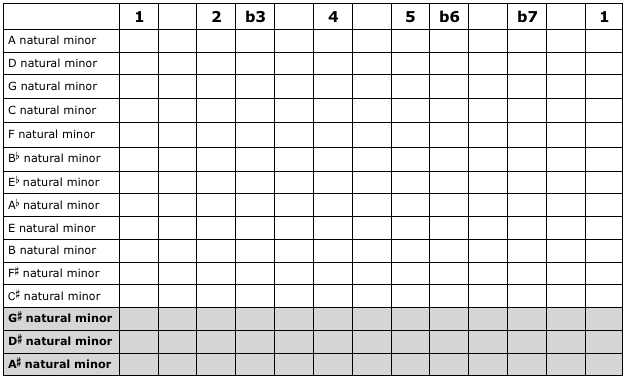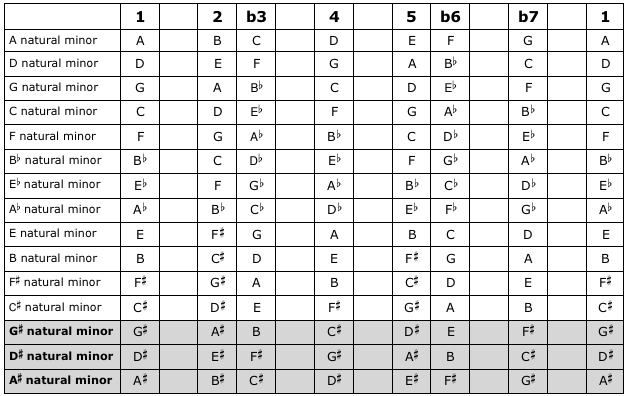In this guitar lesson we’re going to take a look at how to work out the notes of any natural minor scale. This scale is also called the pure minor scale, or aeolian mode. And, like the minor pentatonic scale, it’s an absolutely essential scale to know for rock guitar soloing. Countless rock guitar licks and solos use it.
If you haven’t worked through the theory lessons on the major scale and minor pentatonic scale, then I highly recommend doing that before starting this lesson. I’ll wait here now for you to check out those lessons, and then we can continue with the rest of this lesson.
All done? Awesome! Let’s get started by looking at the musical spelling of the natural minor scale…
Musical Spelling Of The Natural Minor Scale
![]()
Notice how I’ve highlighted the 2 and b6? The reason why I’ve done this is to make it clearer that the natural minor scale has exactly the same scale degrees as the minor pentatonic scale, but also has a 2 and b6 added to it. Being aware of this should make it easier for you to memorize the musical spelling—especially if you memorized the musical spelling of the minor pentatonic scale when did the theory lesson on the minor pentatonic scale!
How To Use The Musical Spelling Of The Natural Minor Scale
If you checked out the two lessons I recommend earlier, then you should already have a pretty good idea how to do this. But to make things 100% clear, it’s probably a great idea to look at an example…
Example: C Natural Minor Scale
What we’re going to do now is work out the notes of the C Natural Minor scale. To do that, we need to take the following steps…
Step 1: Write out the notes of the C major scale. Doing this will give us…

Step 2: Because the musical spelling of the natural minor scale has a b3, b6 and a b7, we need to flatten the 3, 6 and 7 of the C major scale. Doing this would give us this…

These are the notes of the C Natural Minor scale.
Now It’s Your Turn!
I think it would be a fantastic idea to take the time to work out the notes of all the natural minor scales. So here’s a table for you to print out and complete. Rather than filling it all out at once, I recommend working out just a few scales a day. This will stop it from feeling like a chore, and the regular daily review will help you learn the material better.
Oh yeah, one last thing before you get started. The last few keys can’t be worked out using the method we looked at in the example. But don’t panic. After the table I’ll give you a very easy method that you can use for those keys. 🙂

Probably the easiest way to work out the last three keys is to raise all the notes of the non-sharp versions by one half-step. Let’s look at an example so that you can see what I mean…
Example: D# Natural Minor Scale
Let’s work out the notes of D# Natural Minor scale…
Step 1: Write down the notes of the D Natural Minor scale…
D E F G A Bb C D
Step 2: Raise all the notes by one half-step. This would give us the notes of the D# Natural Minor scale…
D# E# F# G# A# B C# D#
I told you this was an easy method. 🙂 Now you’re ready to complete the table. Once you’ve done that, then you can check out the answers below…

Putting This Theory Into Practice
In my opinion, it’s absolutely critical to apply any music theory that you learn as soon as possible. This helps you to turn something that is purely academic into something that will actually help improve your playing. So let’s look at one way to apply this theory right now. Please do the following things as soon as you can…
- Print out this webpage and map the notes of the C Natural Minor scale onto the blank fretboard diagram that I’ve included below. My preference is to write down the scale degree numbers, but you might want to write down the note names instead. It doesn’t really matter what you choose to do.
- Record the following chord progression onto your computer, or any other recording device that’s convenient for you. Don’t worry too much about what strumming pattern you use for the chords. Just be sure to play the C Minor chord for four beats, the Bb Major chord for two beats, and the Ab Major chord for two beats.

- Once you’ve recorded the chord progression, then improvise over it using notes of the C Natural Minor scale. Be sure to listen carefully to how the notes sound over the chords. If you do this on a regular basis, then you’ll really get to know the unique personality that each note of the scale has.
C Natural Minor Scale: C D Eb F G Ab Bb

Have fun!
Return To: Guitar Music Theory Lessons